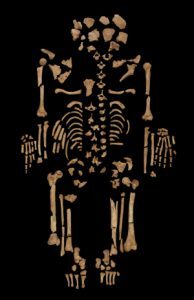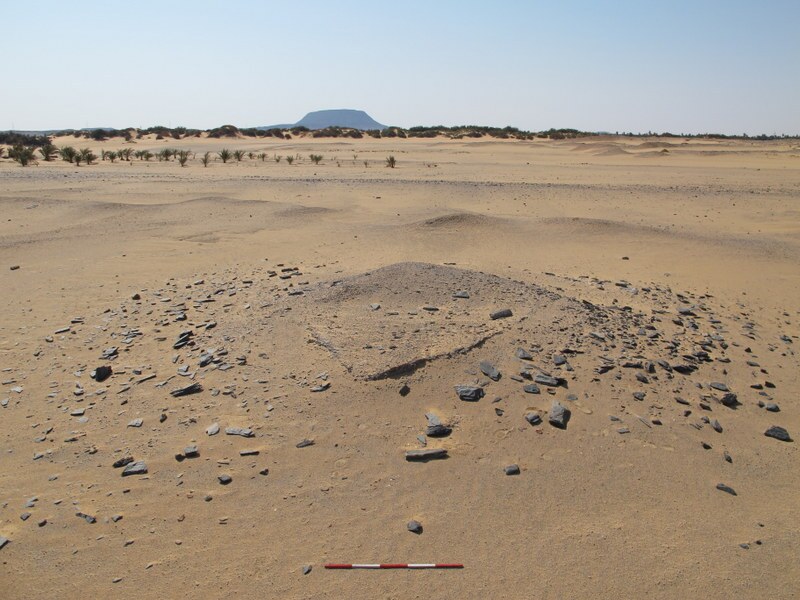
Archaeologists have found the oldest complete example in the world of a human with metastatic cancer in a 3,000 year-old skeleton.
The findings are reported in the academic journal PLOS ONE today (17 March, 2014).
The finding came from a skeleton of a young adult male found by a Durham University PhD student in a tomb in modern Sudan in 2013. Dating back to 1200 BCE, it was estimated to be between 25-35 years old when he died and was found at the archaeological site of Amara West in northern Sudan, situated on the Nile, 750 km downstream of the country’s modern capital, Khartoum. It was buried extended on his back, within a badly deteriorated painted wooden coffin, and provided with a glazed faience amulet as a grave good.
The skeleton was examined by experts at Durham University and the British Museum using radiography and a scanning electron microscope (SEM) which resulted in clear imaging of the lesions on the bones. It showed cancer metastasized on the collar bones, shoulder blades, upper arms, vertebrae, ribs, pelvis and thigh bones. It is the oldest convincing complete example of metastatic cancer in the archaeological record.
Lead author, Michaela Binder, a PhD student in the Department of Archaeology at Durham University, excavated and examined the skeleton. She said: “Our analysis showed that the shape of the small lesions on the bones can only have been caused by a soft tissue cancer even though the exact origin is impossible to determine through the bones alone.”
“Insights gained from archaeological human remains like these can really help us to understand the evolution and history of modern diseases,” she added. “Very little is known about the antiquity, epidemiology and evolution of cancer in past human populations apart from some textual references and a small number of skeletons with signs of cancer.”
The cause of the cancer can only be speculative but the researchers say it could be as a result of environmental carcinogens such as smoke from wood fires, through genetic factors, or from infectious diseases such as schistosomiasis which is caused by parasites.
They say that an underlying schistosomiasis infection seems a plausible explanation for the cancer in this individual as the disease had plagued inhabitants of Egypt and Nubia since at least 1500 BCE, and is now recognised as a cause of bladder cancer and breast cancer in men.
The researchers from Durham University and the British Museum say the discovery will help to explore underlying causes of cancer in ancient populations and provide insights into the evolution of cancer in the past. Ancient DNA analysis of skeletons and mummies with evidence of cancer can be used to detect mutations in specific genes that are known to be associated with particular types of cancer.
Even though cancer is one of the world’s leading causes of death today, it remains almost absent from the archaeological record compared to other pathological conditions, giving rise to the conclusion that the disease is mainly a product of modern living and increased longevity. These findings suggest that cancer is not only a modern disease but was already present in the Nile Valley in ancient times.
_________________________________
Aerial view over the north-eastern cemetery area at Amara West with the Nile and the ancient settlement in the background. © Trustees of the British Museum
__________________________________
Nubian-style burial mound marking the grave on the surface. © Trustees of the British Museum
_______________________________
The skeleton in its original burial position in the western chamber. The insert shows faience amulet found associated with the individual from both sides. The Egyptian god Bes (right side) is depicted on the reverse side. © Trustees of the British Museum
_____________________________
The skeleton of the adult male excavated from Amara West. The skeleton shows signs of metastatic carcinoma. © Trustees of the British Museum
_____________________________
Previously, there has only been one convincing, and two tentative, examples of metastatic cancer predating the 1st millennium BC reported in human remains. However, because the remains derived from early 20th century excavations, only the skulls were retained, thus making a full re-analysis of each skeleton, to generate differential (possible) diagnoses, impossible.
Co-author, Dr Neal Spencer from the Department of Ancient Egypt and Sudan at the British Museum, said: “From footprints left on wet mud floors, to the healed fractures of many ancient inhabitants, Amara West offers a unique insight into what it was like to live there – and die – in Egyptian-ruled Upper Nubia 3200 years ago.”
Michaela Binder added: “Through taking an evolutionary approach to cancer, information from ancient human remains may prove a vital element in finding ways to address one of the world’s major health problems.”
The tomb, where the skeleton was found, appears to have been used for high-status individuals from the town, but not the ruling elite, based on the tomb architecture and aspects of funerary ritual.
The tomb’s architecture is evidence of a hybrid culture blending Pharaonic elements (burial goods, painted coffins) with Nubian culture (a low mound to mark the tomb).
The well preserved pottery recovered from the tomb provides a date within the 20th Dynasty (1187-1064 BCE), a period when Egypt ruled Upper Nubia, endured conflicts with Libya and while pharaohs such as Ramses III were being buried in the Valley of the Kings.
The research was funded by the Leverhulme Trust and the Institute of Bioarchaeology Amara West Field School, with the permission of the National Corporation of Antiquities and Museums in Sudan.
______________________________
Edited from a press release from the Durham University Media Relations Office.
______________________________
Read about the most fascinating discoveries with a premium subscription to Popular Archaeology Magazine. Find out what Popular Archaeology Magazine is all about. AND MORE:
 On the go? Purchase the mobile version of the current issue of Popular Archaeology Magazine here for only $2.99.
On the go? Purchase the mobile version of the current issue of Popular Archaeology Magazine here for only $2.99.
And, Popular Archaeology’s annual Discovery edition is a selection of the best stories published in Popular Archaeology Magazine in past issues, with an emphasis on some of the most significant, groundbreaking, or fascinating discoveries in the fields of archaeology and paleoanthropology and related fields. At least some of the articles have been updated or revised specifically for the Discovery edition. We can confidently say that there is no other single issue of an archaeology-related magazine, paper print or online, that contains as much major feature article content as this one. The latest issue, volume 2, has just been released. Go to the Discovery edition page for more information.
Subscription Price: A very affordable $5.75 for those who are not already premium subscribers of Popular Archaeology Magazine (It is FREE for premium subscribers to Popular Archaeology). Premium subscribers should email [email protected] and request the special coupon code. Or, for the e-Book version, it can be purchased for only $3.99 at Amazon.com.








